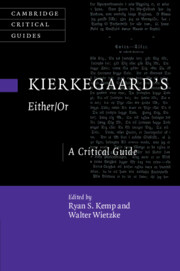Book contents
- Kierkegaard’s Either/Or
- Cambridge Critical Guides
- Kierkegaard’s Either/Or
- Copyright page
- Contents
- Contributors
- Acknowledgments
- Abbreviations
- Introduction
- Chapter 1 Existential Melancholia
- Chapter 2 Don Giovanni and the Musical-Erotic
- Chapter 3 For What May the Aesthete Hope?
- Chapter 4 Companions in Guilt
- Chapter 5 A’s Religion of Boredom
- Chapter 6 The Artist Is Not Present
- Chapter 7 Failed Temporalities in Either/Or
- Chapter 8 Love, Marriage, and Delusion in Either/Or
- Chapter 9 The Philosophy of Science in Either/Or
- Chapter 10 The Despair of Judge William
- Chapter 11 The Problem of Evil in Either/Or
- Chapter 12 Illusions of Ethical Independence
- References
- Index
- Cambridge Critical Guides
Chapter 2 - Don Giovanni and the Musical-Erotic
Published online by Cambridge University Press: 16 November 2023
- Kierkegaard’s Either/Or
- Cambridge Critical Guides
- Kierkegaard’s Either/Or
- Copyright page
- Contents
- Contributors
- Acknowledgments
- Abbreviations
- Introduction
- Chapter 1 Existential Melancholia
- Chapter 2 Don Giovanni and the Musical-Erotic
- Chapter 3 For What May the Aesthete Hope?
- Chapter 4 Companions in Guilt
- Chapter 5 A’s Religion of Boredom
- Chapter 6 The Artist Is Not Present
- Chapter 7 Failed Temporalities in Either/Or
- Chapter 8 Love, Marriage, and Delusion in Either/Or
- Chapter 9 The Philosophy of Science in Either/Or
- Chapter 10 The Despair of Judge William
- Chapter 11 The Problem of Evil in Either/Or
- Chapter 12 Illusions of Ethical Independence
- References
- Index
- Cambridge Critical Guides
Summary
This essay discusses immediate, or “erotic,” aesthetic agency, the first of several stages of the figure of the aesthete in Either/Or. Erotic aesthetic agency consists in an almost naïve, all but nonpurposive pursuit of occasions to exercise the power to overwhelm the wills of others in one’s sheer desire of them, to incorporate them in one’s own terms by operation of simple impulse. The effect of this agency on others is to subject them to desire as such, that is, to desire as a force that binds them to the Don. But the ultimate aim of the agency is its existence: that it be. The conceptual structure of Kierkegaard’s understanding of this starting point in the aesthetic view of the world, as it is presented by a self-professed fictional aesthete, is explored with reference to the figure that organizes much of the portrayal of the erotic aesthete, Don Juan, as he appears in Mozart and Da Ponte’s opera Don Giovanni. Special attention is paid both to details of the opera as Kierkegaard would have experienced it and to the slippage between a reflective aesthete, A, imagining an unreflective aesthete, the Don, as an ideal.
- Type
- Chapter
- Information
- Kierkegaard's Either/OrA Critical Guide, pp. 25 - 41Publisher: Cambridge University PressPrint publication year: 2023

